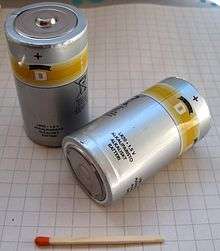D battery


A D battery (D cell or IEC R20) is a size of dry cell. A D cell is cylindrical with an electrical contact at each end; the positive end has a nub or bump. D cells are typically used in high current drain applications, such as in large flashlights, radio receivers and transmitters, boomboxes, products with electric motors, safety systems, Geiger counters, megaphones, or other applications that require an extended running time. A D cell may be either rechargeable or non-rechargeable. Its terminal voltage and capacity depend upon its cell chemistry.
The National Carbon Company introduced the first D cell in 1898. Before smaller cells became more common, D cells were widely known as flashlight batteries. The U.S. military designation for this battery has been BA-30 since sometime before World War II.[1] During World War II it was designated the Type C battery by the Navy leading to confusion with the smaller C cell battery (BA-42).
In 2007, D batteries accounted for 8% of alkaline primary battery sales (numerically) in the US. In 2008, Swiss purchases of D batteries amounted to 3.4% of primary and 1.4% of secondary sales.[2][3]
Dimensions and capacity

| Zinc–carbon | Alkaline | Li-FeS2 | NiCd | NiMH | |
|---|---|---|---|---|---|
| IEC name | R20 | LR20 | FR20 | KR20 | HR20 |
| ANSI/NEDA name | 13D | 13A | 13LF | ||
| Typical capacity | 8000 mAh | 12000-18000 mAh | 2000-5500 mAh | 2200–12000 mAh | |
| Nominal voltage | 1.5 V | 1.5 V | 1.5 V | 1.25 V | 1.25 V |
| Rechargeable | No | Special type only | No | Yes | Yes |
A battery's capacity depends upon its cell chemistry and current draw. Energizer brand rates its alkaline D cell at approximately 20,000mAh at 25mA draw, but estimates performance closer to about 10,000mAh at 500mA draw.[4] This effect is generally less pronounced in cells with NiCd and NiMH chemistries; see Peukert's law. Many commonly available size D rechargeable cells are actually sub-C cells in a D-sized holder.
D batteries have:
Nominal diameter of 33.2 ± 1 millimeters (1.3 inches).
Overall length of 61.5 millimeters (2.42 inches).
[5]
Other common names
- HP2 / SP2 / U2 (In Britain until the 1980s)
- Flashlight Battery
- MN1300
- MX1300
- Mono
- Goliath
- Torcioni (Italy)
- Type 373 (Soviet Union/Russia)
- BA-30 (US Military Spec World War II–1980s)
- UM 1 (JIS)
- #1 (China)
- 6135-99-464-1938 (NSN)(carbon-zinc)
- 6135-99-109-9428 (NSN)(alkaline)
- Pilhão (Brazil)
- Pila Grande (Argentina)
- Kalın pil (Turkey)
- Monočlánek / "Buřt" (Czech republic)
See also
References
External links
- Brand Neutral Drawing Of Alkaline D Battery Based On ANSI Specifications
- Brand Neutral Drawing Of NiCd D Battery Based On ANSI Specifications
- Brand Neutral Drawing Of NiMH D Battery Based On ANSI Specifications
- Energizer D Size Battery Specification for Alkaline Cell
- Duracell D Size Battery Specification